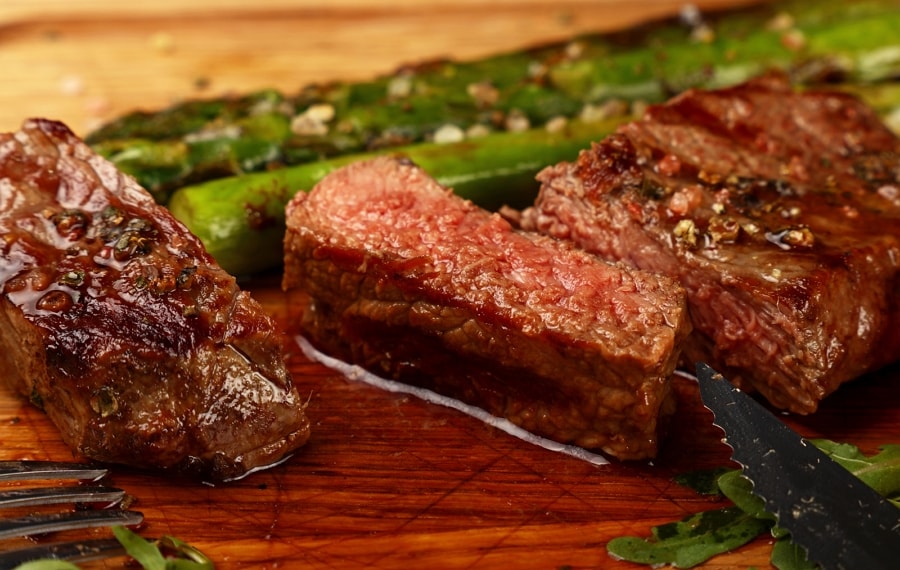Imagine the morning sun shining through the window, casting its light on the kitchen cutting board where you are preparing a hearty breakfast. The star in your hands, slices of delicious bacon, awaits your touch to come to life.
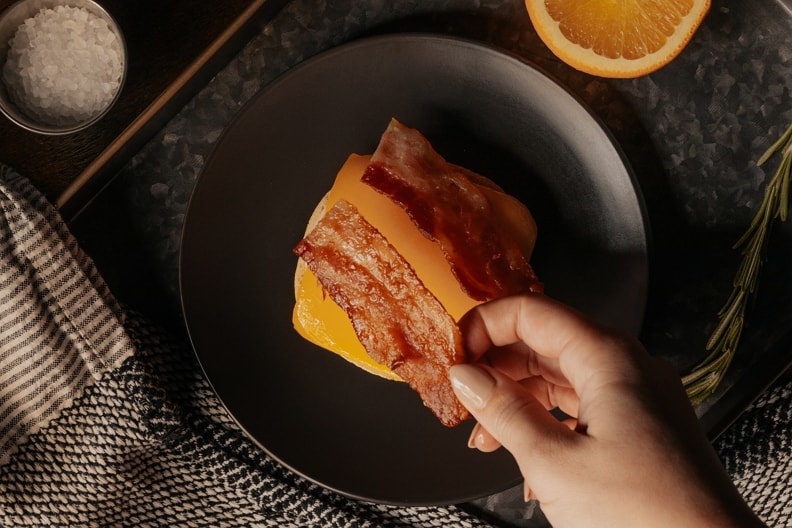
The right way to cook bacon will bring out its irresistibly delicious aroma and unmatched texture. But, do you know how to make the perfect bacon?
Cooking bacon may seem simple, but it’s actually quite challenging.
The Challenges of Cooking Bacon
Bacon is made up of two completely different elements: the fat and the lean. These parts each have their own best cooking methods, and finding the right balance between them is tricky. The thickness of the bacon also plays a crucial role in how it’s cooked. Regularly sliced bacon is about 1/16 inch thick, while thick-cut bacon is about 1/8 inch thick.
So, you might face challenges like how to cook it evenly, deal with the fat, achieve the desired texture, and keep the bacon’s shape. However, once you master the right techniques, you can easily cook delicious bacon.
In this article, we’ll dive into various ways to cook bacon, including on the Stovetop, in the Oven, in the Microwave, using Sous vide, and in an Air Fryer. We’ll discuss the pros and cons of each method and how to overcome the challenges in cooking. Whether you’re a beginner or looking for new cooking ideas, this article will offer valuable guidance.
Way 1: Cooking Bacon on the Stovetop – Not Recommended
Cooking bacon on the stovetop is one of the most traditional methods. It involves frying the bacon in a pan over direct heat, allowing for precise control over the cooking process.

Pros
- Faster: Compared to using an oven or sous vide, cooking bacon on the stovetop is much quicker.
Cons
- Grease Splatter: This is an inevitable issue with stovetop cooking. As the bacon’s fat heats up, it splatters everywhere, making it hard to clean and posing a risk of burns.
- Requires Cooking Experience: Frequent flipping is necessary, and a certain level of experience is needed to achieve the desired texture. Otherwise, you might end up with burnt bacon and smoking fat, indicating that the heat is too high.
- Limited Cooking Quantity: You can typically cook about 4 slices at a time; it’s difficult to cook more than that.
- Uneven Cooking: When using non-stick pans or other thin pans, you might face uneven heat distribution. Even timely flipping doesn’t fully solve this problem. Perhaps using a cast-iron skillet could alleviate uneven cooking to some extent.
Way 2: Cooking Bacon in the Oven – Perfect for Feeding a Crowd
Cooking bacon in the oven mainly relies on the oven’s even heat distribution, using convection to evenly cook the bacon over a set period. During the baking process, the fat from the bacon slowly renders out, making the bacon crisper and more flavorful.
When cooking bacon in the oven, you can use a rack or a baking sheet. For easier cleanup, you can also line the baking sheet with aluminum foil or parchment paper. The oven is typically set to 375-430°F (190-220°C). Regular thickness bacon usually takes about 18 minutes, while thick-cut bacon takes around 24 minutes. Adding the time for the oven to preheat, which is generally over 10 minutes, the overall cooking time becomes relatively long.

Cooking Bacon on a Baking Sheet
Pros:
- Large Quantity: This method allows for cooking a large amount of bacon at once, making it ideal for big batches.
- Even Cooking: The oven provides a steady heat, ensuring the bacon cooks evenly.
- Easy Clean-up: Using parchment paper or aluminum foil makes cleaning up a breeze. Simply remove the used paper or foil and clean the baking sheet.
Cons:
- Longer Cooking Time: Baking bacon in the oven takes longer compared to cooking on the stovetop, in the microwave, or in an air fryer.
- Greasier Texture: While parchment paper or aluminum foil can absorb some of the fat, some grease will still remain on the bacon, resulting in a greasier texture.
Cooking Bacon on a Baking Rack
Pro:
- Large Quantity: This method allows for cooking a significant amount of bacon at once, making it great for preparing large batches.
- Even Cooking: The oven’s steady heat ensures the bacon cooks uniformly.
- Less Grease: The rack allows the fat to drip off the bacon, making it less greasy. Additionally, the dripped bacon fat can be collected and used for cooking other dishes.
Cons:
- Longer Cooking Time: Baking bacon in the oven takes more time compared to using the stovetop, microwave, or air fryer.
- Harder to Clean: The rack can be more difficult to clean compared to cooking on a baking sheet lined with parchment paper or aluminum foil, as the grease may drip onto the baking sheet and become baked on.
Way 3: Cooking Bacon in the Microwave – Not Recommended
Cooking bacon in the microwave works by emitting microwaves that excite the water molecules in the food, creating friction and heat, which cooks the bacon.
Pros:
- Very Fast: Some people consider this a good method for cooking bacon because it’s very quick. For regular thickness bacon (1/16 inch), it takes about 4-4.5 minutes, and for thick-cut bacon (1/8 inch), it takes about 4.5-5.5 minutes. Plus, if you use microwave-safe dishes and paper towels, cleaning up should be easy.
Cons:
- Uneven Cooking: The way microwaves cook can lead to unevenly cooked food, and bacon is no exception. The bacon might not turn out as crispy as desired.
- Limited Quantity: Only a small amount of bacon can be cooked at a time, typically around 4 slices.
Way 4: Sous vide Bacon – Best Way to Cook Thick Bacon
The sous vide method involves vacuum-sealing the bacon in a bag and cooking it at a precisely controlled low temperature. The ideal cooking temperature is 145°F (63°C), with a minimum cooking time of eight hours, followed by a quick sear to create a crispy exterior.
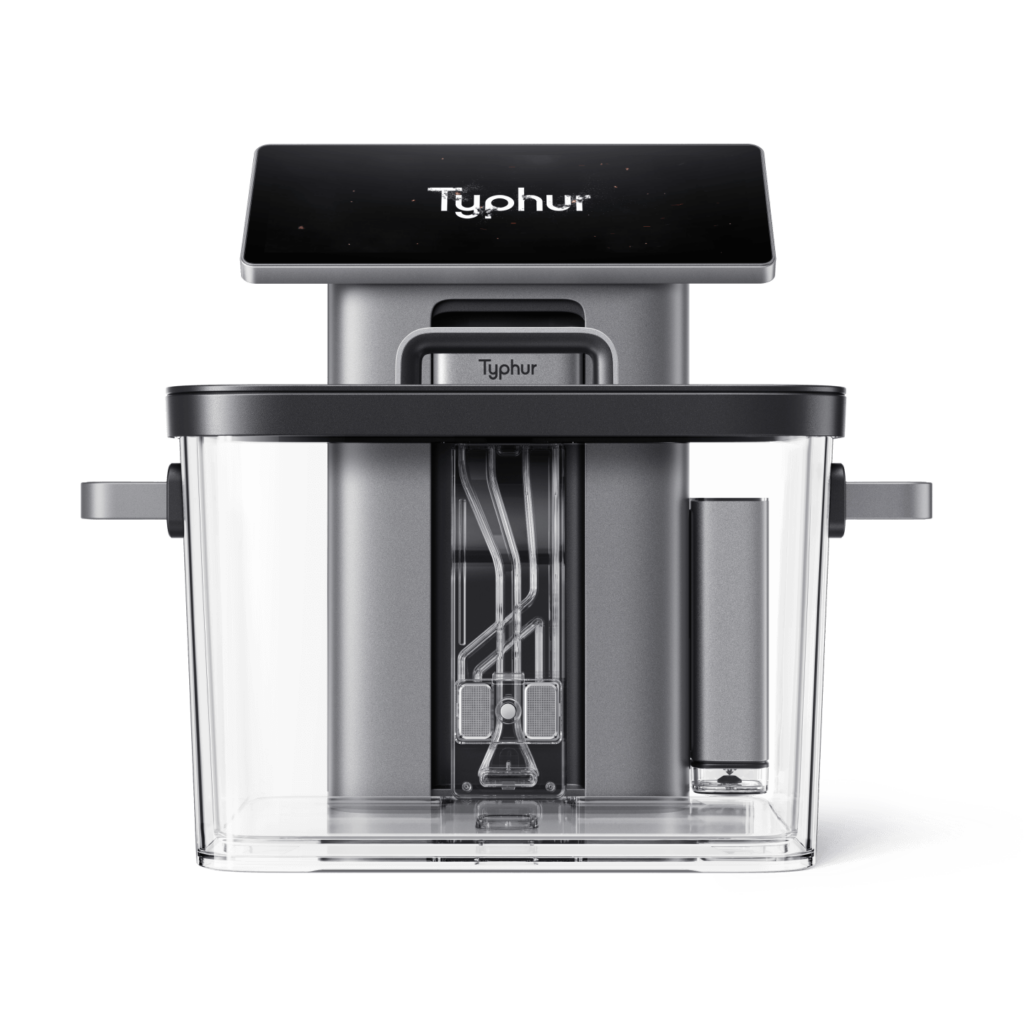
All-in-One Sous Vide Machine
Pros:
- Perfection to Texture: Sous vide makes bacon evenly cooked, resulting in a crisp seared surface and melty, tender interior.
- Large Quantity: You can cook a whole pack of bacon, or as many as fit in your water bath, all in one go. Afterward, you can store it right in the vacuum-sealed bag in the refrigerator. (It’s also possible to freeze it for longer storage.) When it’s time to eat, simply open the pack, take out the partially cooked bacon, give it a quick sear, and it’s ready to serve.
Cons:
- Long Cooking Time: Compared to other methods, sous vide takes significantly longer and is more suited for thick-cut bacon (the thicker the better). Thin bacon may lose the juicy texture achieved through sous vide during the searing process, defeating the purpose of sous vide.
- Equipment Requirement: This method may require special equipment like a sous vide immersion circulator, vacuum sealer, and vacuum bags.
In this case, using a Typhur Sous Vide Station is recommended as known as the world’s first all-in-one design, integrating the water tank and main unit. It comes with a vacuum machine, vacuum bags, weights, and a 12.3-inch touchscreen with built-in recipes, making it easy and convenient to cook perfect bacon.

Way 5: Air Fry Bacon – Crispy and Less Oil
Cooking bacon in an air fryer bacon is similar to an oven, using hot air convection to heat the bacon and make it crispy. Air fryers have become popular in recent years due to their cooking speed and convenience.
Pros:
- Less Oil: Air fryer bacon using hot air convection, no additional oil to add. They also conveniently collect bacon grease, which can be used to enhance the flavor of other dishes.
- Crispy Texture: The air fryer can make the bacon crispy. If you prefer bacon with a bit more chew, simply reduce the cooking time by a few minutes.
- Very Fast: It’s a relatively quick method for cooking bacon. For instance, using the Typhur Dome air fryer, it only takes about 8 minutes to cook a batch of bacon.
Cons:
- Limited Cooking Space: Due to the limited space in most air fryers, only a small amount of bacon can be cooked at a time. Some may even require folding or cutting the bacon to fit.
- Potential Deformation: The need for rapid heat exchange in air frying means that most air fryers have non-adjustable and high fan speeds. This can cause thin-sliced bacon (1/32 inch) or even regular bacon (1/16 inch) to be blown around, leading to folding or deformation, which results in uneven cooking.
Best Air Fryer to Cook Bacon
To enhance user experience and make it easier to produce crispy bacon, Typhur was inspired by the pizza oven, and launched the Typhur Dome air fryer.
Typhur Dome features a flat and curved interior, combined with fluid dynamics analysis. Through structural modeling and fluid simulation design verification, it not only upgrades the air fryer’s capacity by 200% but also ensures even cooking while achieving the fastest cooking speed (#1 in cooking speed). The Typhur Dome can cook about 8 slices of bacon at once in just 8 minutes, resulting in a crispy texture. Additionally, the Typhur Dome offers adjustable fan speed. When using the preset bacon function, you’ll notice that it operates at a lower wind speed, perfectly avoiding the risk of thin or regular bacon slices being blown away or displaced, ensuring even cooking for every slice.
* Video created by bothegoattv: https://www.instagram.com/bothegoattv/reels/
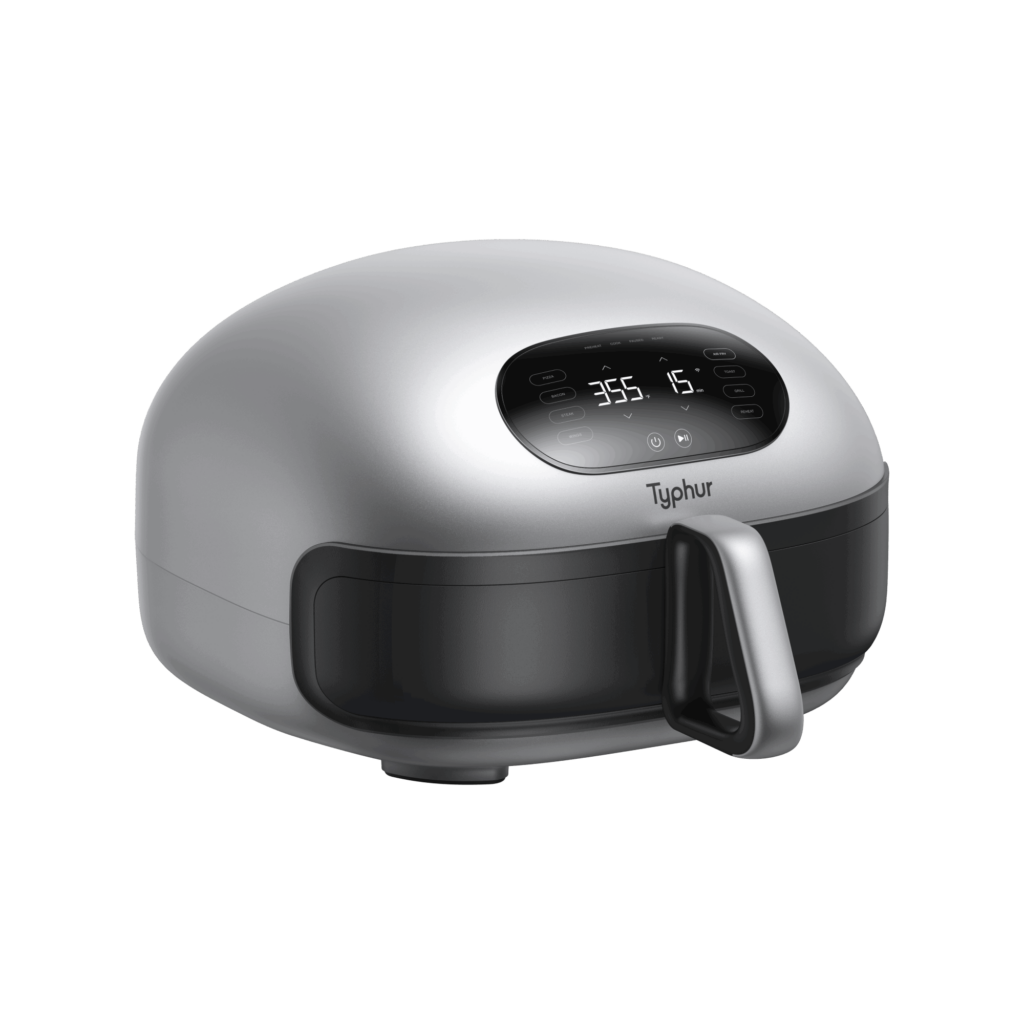
Dual Heating Elements
In summary, the best method for cooking bacon depends on how much you need to prepare and your preferred texture.
For a comprehensive cooking experience and convenience, we suggest you try the Typhur Dome air fryer bacon. Here is the step-by-step recipe.
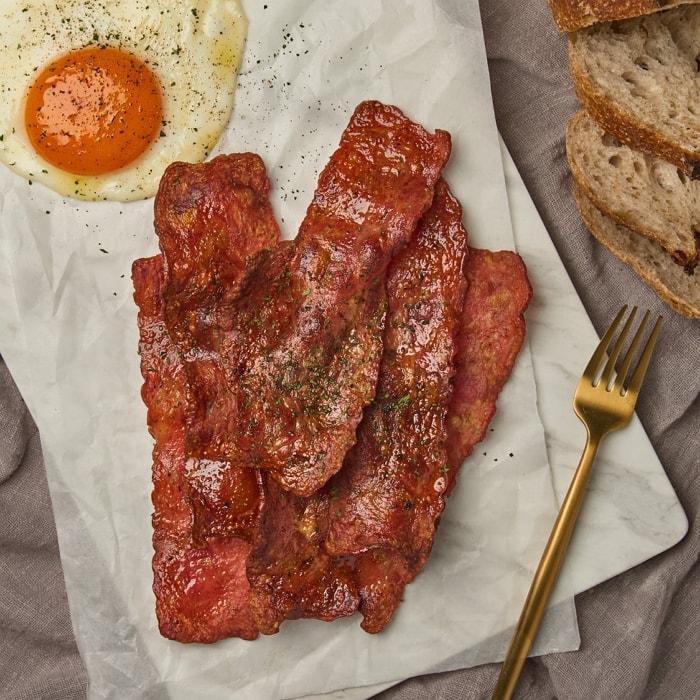
- Preheat the Typhur Dome to 400°F/ 205°C. (Around 5 minutes)
- After the Typhur Dome has finished preheating, carefully place the sliced bacon in a single layer and return it to the air fryer. For the best results, make sure that you do not overcrowd the Typhur Dome.
- Cook your bacon for 10 minutes at 400 °F. If using thick-cut bacon, you may need to add a few minutes.
- Using a pair of tongs, carefully remove the crispy bacon from a plate or serving tray.
- Whether you enjoy your bacon first thing in the morning with your breakfast, this is the recipe for you.

